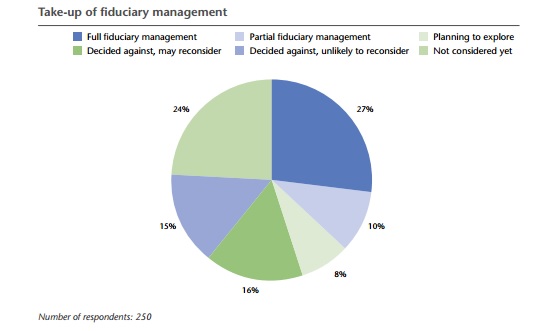Any other business: Gamification, according to Gabe Zicherman, a technology guru and chair of GSummit, is “the process of using game thinking and game dynamics to engage audiences and solve problems”.
Latest articles from Lisa Botter
IBM adds cat bonds to mix as it diversifies return-seeking assets
IBM Pension Plan has invested £60m in catastrophe bonds as it decreases its exposure to higher-risk assets and focuses on investments that will provide a diversified source of return.
Warwickshire latest to dump fund after star manager departure
Warwickshire County Council Pension Fund has revealed it sold its assets in Baring Asset Management’s dynamic asset allocation strategy earlier this year due to the departure of the product’s manager.
Schemes make record gilts investment, and three other key ONS charts
Schemes invested heavily in fixed income assets – including government, corporate and overseas bonds – last quarter. Anticipated rate rises, schemes derisking out of equities and even switching from synthetic to real gilt holdings have all been investment drivers.
Data released by the Office for National Statistics show investment in gilts, including index-linked gilts, remained high in the second quarter of this year, with schemes ploughing £8.3bn into the asset class. Following a strong Q1 when £7.9bn was allocated the Q2 figure is the largest since this series of data began in 1963.
Schemes invested more than £6bn in non-indexed gilts of varying maturities, up from £2.7bn in the first quarter of the year. However, investment in index-linked bonds was down, with slightly more than £2bn invested, compared with more than £5bn in Q1.
Schemes also increased investment in corporate bonds, with almost £900m invested in UK corporate bonds and more than £2bn in overseas assets.
USS weighs in on active v passive debate
FT Investment Management Summit: The Universities Superannuation Scheme has extolled the virtues of internal active equity management but criticised external managers for not consistently adding value.
Tesco chooses cash flow matching over strategic asset allocation
FT Investment Management Summit: Tesco Pension Fund has moved away from strategic asset allocations towards a risk-based investment strategy, which allows the scheme to get the right mix of assets to meet future cash flows.
Active managers dealt another blow, but schemes still loyal
A survey released this week found passive funds outperformed active funds by 4.7 per cent over the past five years, adding fuel to the fire of the active versus passive management debate.
The research conducted by specialist fiduciary manager Charles Stanley Pan Asset reported that over five years that could mean £3.8m of additional return a year for a corporate scheme of £500m.
Or it could mean a savings of £441m a year for the Local Government Pension Scheme.
It is important to bear in the mind that CSPA does offer a passive fiduciary management service, but the findings are still relevant.
This comes after the government suggested local authority schemes move into a passive collective investment vehicle for their listed assets. It claimed this could save £420m a year for the LGPS.
Corporate schemes catching public sector on infra
Corporate schemes are catching up with their public sector counterparts in accessing the illiquidity premium of infrastructure investments, taking an increasing share of a growing asset class.
Why UK schemes lose out to nimble overseas competitors on infrastructure
Infrastructure has been a hot topic among UK schemes over the past couple of years. With its long-term matching characteristics, it seems like a perfect fit for schemes looking to match liabilities, but inflows have been muted.
UK schemes have created “a lot of talk, not much action”, as Anthony Fasso, chief executive at asset manager AMP Capital told me this week.
So has little changed? Last year, John MacDonald, head of manager research at Hymans Robertson, said: “There is probably a lot of pent-up demand for infrastructure, which will be realised once the [Pensions Infrastructure Platform] is finalised.”
The Pip was finalised and launched at the beginning of this year, but with a less-than-stellar reception as two of its founding members retreated from the fund due to its risk profile.
One factor Fasso did point to was the competition UK schemes are facing from their international counterparts. He added that while UK trustee boards are still getting their heads around infrastructure as an asset class, UK infrastructure was “being snapped up by other pension schemes”.
Fid man take-up stubbornly slow: five key charts
Fiduciary management in the UK has long been marketed/talked about, with the promise of taking the responsibility for ever more complicated everyday investment decisions off the hands of trustees seeming almost too good to be true.
But take-up of fid man has been limited. According to a survey by Aon Hewitt (a fiduciary manager and consultancy) released yesterday, 37 per cent of respondents currently have some sort of fiduciary solution in place. This is only a slight uptick on 36 per cent in last year’s survey and 18 per cent in 2011.

Source: Aon Hewitt
Of those that have a fiduciary provider in place, 75 per cent have opted for full delegation.

